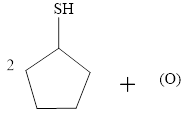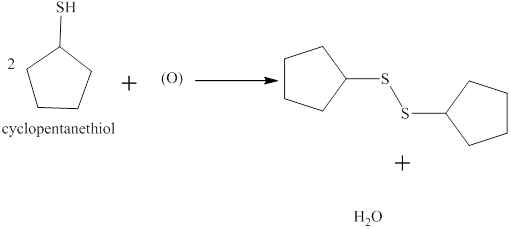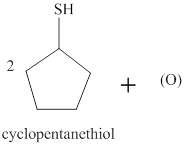
Concept explainers
Complete the following reactions:
a.
b.
c.
(a)
Interpretation:
The complete reaction between
Concept introduction:
A chemical reaction is a process in which rearrangement of atom or ions takes place between two reacting species. A balanced chemical equation represents an equation in which all the reactants and products are written with their stoichiometric coefficients. The number of atoms of an element on both sides of the equation is equal.
Answer to Problem 13.51E
The completed reaction between
Explanation of Solution
The incomplete reaction is shown below.

Figure 1
The thiols react with heavy metal ions such as
Therefore, the completed reaction between
The completed reaction between
(b)
Interpretation:
The complete reaction between cyclopentanethiol and nascent oxygen atom is to be stated.
Concept introduction:
A chemical reaction is a process in which rearrangement of atom or ions takes place between two reacting species. A balanced chemical equation represents an equation in which all the reactants and products are written with their stoichiometric coefficients. The number of atoms of an element on both sides of the equation is equal.
Answer to Problem 13.51E
The completed reaction between cyclopentanethiol and the nascent oxygen atom is shown below.

Explanation of Solution
The incomplete reaction is shown below.

Figure 2
Two molecules of thiol undergo an oxidation reaction with a nascent oxygen atom. The thiol molecules react with a nascent oxygen atom to form a disulfide compound. Therefore, the completed reaction between cyclopentanethiol and the nascent oxygen atom is shown below.

Figure 3
The completed reaction between cyclopentanethiol and the nascent oxygen atom is shown in Figure 3.
(c)
Interpretation:
The complete reaction between
Concept introduction:
A chemical reaction is a process in which rearrangement of atom or ions takes place between two reacting species. A balanced chemical equation represents an equation in which all the reactants and products are written with their stoichiometric coefficients. The number of atoms of an element on both sides of the equation is equal.
Answer to Problem 13.51E
The complete reaction between
Explanation of Solution
The incomplete reaction is shown below.
A disulfide compound undergoes reduction reaction with a nascent hydrogen atom to form two thiol molecules.
Therefore, the complete reaction between
The complete reaction between
Want to see more full solutions like this?
Chapter 13 Solutions
Bundle: Chemistry for Today: General, Organic, and Biochemistry, Loose-Leaf Version, 9th + LMS Integrated OWLv2, 4 terms (24 months) Printed Access Card
- Nonearrow_forwardIn the solid state, oxalic acid occurs as a dihydrate with the formula H2C2O4 C+2H2O. Use this formula to calculate the formula weight of oxalic acid. Use the calculated formula weight and the number of moles (0.00504mol) of oxalic acid in each titrated unknown sample recorded in Table 6.4 to calculate the number of grams of pure oxalic acid dihydrate contained in each titrated unknown sample.arrow_forward1. Consider a pair of elements with 2p and 4p valence orbitals (e.g., N and Se). Draw their (2p and 4p AO's) radial probability plots, and sketch their angular profiles. Then, consider these orbitals from the two atoms forming a homonuclear л-bond. Which element would have a stronger bond, and why? (4 points)arrow_forward
- Write the reaction and show the mechanism of the reaction. Include the mechanism for formation of the NO2+ 2. Explain, using resonance structures, why the meta isomer is formed. Draw possible resonance structures for ortho, meta and para.arrow_forwardNonearrow_forward3. A molecular form of "dicarbon", C2, can be generated in gas phase. Its bond dissociation energy has been determined at 599 kJ/mol. Use molecular orbital theory to explain why energy of dissociation for C₂+ is 513 kJ/mol, and that for C2² is 818 kJ/mol. (10 points)arrow_forward
- 9.73 g of lead(IV) chloride contains enough Cl- ions to make ____ g of magnesium chloride.arrow_forward6. a) C2's. Phosphorus pentafluoride PF5 belongs to D3h symmetry group. Draw the structure of the molecule, identify principal axis of rotation and perpendicular (4 points) b) assume that the principal axis of rotation is aligned with z axis, assign symmetry labels (such as a1, b2, etc.) to the following atomic orbitals of the P atom. (character table for this group is included in the Supplemental material). 3s 3pz (6 points) 3dz²arrow_forward2. Construct Lewis-dot structures, and draw VESPR models for the ions listed below. a) SiF5 (4 points) b) IOF4 (4 points)arrow_forward
 Chemistry & Chemical ReactivityChemistryISBN:9781337399074Author:John C. Kotz, Paul M. Treichel, John Townsend, David TreichelPublisher:Cengage Learning
Chemistry & Chemical ReactivityChemistryISBN:9781337399074Author:John C. Kotz, Paul M. Treichel, John Townsend, David TreichelPublisher:Cengage Learning Chemistry & Chemical ReactivityChemistryISBN:9781133949640Author:John C. Kotz, Paul M. Treichel, John Townsend, David TreichelPublisher:Cengage Learning
Chemistry & Chemical ReactivityChemistryISBN:9781133949640Author:John C. Kotz, Paul M. Treichel, John Townsend, David TreichelPublisher:Cengage Learning Introductory Chemistry: A FoundationChemistryISBN:9781337399425Author:Steven S. Zumdahl, Donald J. DeCostePublisher:Cengage Learning
Introductory Chemistry: A FoundationChemistryISBN:9781337399425Author:Steven S. Zumdahl, Donald J. DeCostePublisher:Cengage Learning World of Chemistry, 3rd editionChemistryISBN:9781133109655Author:Steven S. Zumdahl, Susan L. Zumdahl, Donald J. DeCostePublisher:Brooks / Cole / Cengage Learning
World of Chemistry, 3rd editionChemistryISBN:9781133109655Author:Steven S. Zumdahl, Susan L. Zumdahl, Donald J. DeCostePublisher:Brooks / Cole / Cengage Learning Chemistry: Principles and ReactionsChemistryISBN:9781305079373Author:William L. Masterton, Cecile N. HurleyPublisher:Cengage Learning
Chemistry: Principles and ReactionsChemistryISBN:9781305079373Author:William L. Masterton, Cecile N. HurleyPublisher:Cengage Learning ChemistryChemistryISBN:9781305957404Author:Steven S. Zumdahl, Susan A. Zumdahl, Donald J. DeCostePublisher:Cengage Learning
ChemistryChemistryISBN:9781305957404Author:Steven S. Zumdahl, Susan A. Zumdahl, Donald J. DeCostePublisher:Cengage Learning





